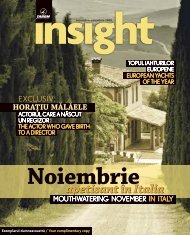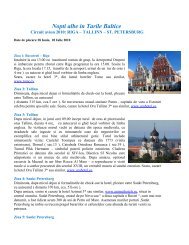Create successful ePaper yourself
Turn your PDF publications into a flip-book with our unique Google optimized e-Paper software.
FEATURE<br />
Însă acum, „Praga şi familia Mucha îşi doresc să vadă Epopeea<br />
Slavă expusă cu demnitate în capitală”, după cum explică<br />
Ondrej Pecha, consilier cultural al capitalei cehe.<br />
Temându-se că oraşul îşi va pierde lucrul cel mai de preţ şi<br />
motivul de bucurie, primăria din Moravsky Krumlov a<br />
împiedicat toate încercările de a muta opera, ignorând faptul că<br />
acordul încheiat cu Praga cu privire la expunerea lucrării a<br />
expirat. „Moravsky Krumlov are dreptul moral incontestabil de<br />
a găzdui aceste picturi”, spune guvernatorul local Michal<br />
Hasek. Încercând să preîntâmpine mutarea lucrării la o galerie<br />
temporară, John Mucha declară că deţine un document din anii<br />
’30 prin care bunicul său, supărat pe autorităţile din Praga,<br />
anulase drepturile capitalei asupra capodoperei sale.<br />
Este vorba despre șapte din cele 20 de pânze, inspirate parţial<br />
din mitologie, de dimensiuni impresionante, măsurând opt<br />
metri pe şase, în timp ce alte opt, cele mai mici din serie,<br />
măsoară aproape cinci metri pe patru.<br />
Mucha, celebru pentru posterele sale înfăţişând-o pe actriţa<br />
franceză Sarah Bernhardt, a călătorit de mai multe ori în Rusia,<br />
Polonia, Serbia şi Bulgaria pentru a se<br />
inspira în crearea Epopeii sale, care<br />
abordează o vastă paletă de teme,<br />
inclusiv abolirea iobăgiei în Rusia.<br />
Primele 11 pânze din serie au fost<br />
expuse la Praga în 1919 şi după aceea<br />
la New York şi Chicago în anii 1920-<br />
1921. Epopeea nu a fost expusă la<br />
Praga până în anul 1928, când a fost<br />
finalizată. Dar în 1933, picturile au<br />
fost puse la păstrare, până în<br />
momentul în care au trebuit să fie<br />
ascunse de nazişti, sub o movilă de cărbune, în timpul celui<br />
de-al Doilea Război Mondial.<br />
După război, lucrările au fost restaurate, iar începând din<br />
1963, sunt expuse în Sala Cavalerilor castelului din Moravsky<br />
Krumlov – o alegere logică din moment ce orăşelul se află la<br />
doar opt kilometri distanţă de Ivancice, oraşul natal al lui<br />
Mucha, care găzduieşte o expoziţie dedicată artistului.<br />
Moravsky Krumlov, în Moravia de Sud, un loc care atrage<br />
numeroşi turişti cu lunga sa tradiţie a vinului şi peisajele<br />
pitoreşti, cum ar fi castelele Lednice şi Valtice, ambele<br />
incluse pe lista monumentelor UNESCO, se opune mutării<br />
Epopeii iar, în mod surprinzător, mulţi oameni din Praga<br />
sunt de aceeaşi părere, temându-se că opera lui Mucha ar<br />
putea să piardă din strălucire într-un oraş deja atât de bogat<br />
în materie de istorie şi artă.<br />
Now, “Prague and the Mucha family want 'The Slav Epic'<br />
displayed with dignity in the capital,” says Ondrej Pecha,<br />
Prague's culture councillor.<br />
Fearing the loss of its pride and joy, Moravsky Krumlov<br />
town hall recently banned any bid to move the work,<br />
ignoring that an agreement with Prague over the work has<br />
expired. “Moravsky Krumlov has an unquestionable moral<br />
right to host these paintings,” contends the local governor<br />
Michal Hasek.<br />
In a bid to prevent any move to a temporary gallery, John<br />
Mucha says he holds a document dating from the 1930s<br />
saying his grandfather, upset by Prague's standpoint, had<br />
cancelled the capital's rights to the work. we’re talking<br />
about seven of the 20 canvases, inspired in part by<br />
mythology, measure a huge eight by six metres, while the<br />
eight smallest works measure nearly five by four metres.<br />
Mucha, famous for his posters depicting French actress<br />
Sarah Bernhardt, took several trips to Russia, Poland,<br />
Serbia and Bulgaria to gather inspiration for the “Epic”,<br />
which depicts such<br />
themes as the abolition<br />
PRAGA ŞI FAMILIA MUCHA ÎŞI DORESC<br />
SĂ VADĂ EPOPEEA SLAVĂ EXPUSĂ CU<br />
DEMNITATE ÎN CAPITALĂ<br />
of serfdom in Russia.<br />
The first 11 canvases in<br />
the cycle were displayed<br />
in Prague in 1919 and<br />
then toured New York<br />
and Chicago in 1920-<br />
1921. The entire “Epic”<br />
was not exhibited in<br />
Prague until 1928, the<br />
year of its completion.<br />
But in 1933, the paintings were rolled up and stored in a<br />
depository, later to be hidden from the Nazis under a<br />
heap of coal during World War II.They were restored after<br />
the war and from 1963 displayed in the Cavaliers' Hall at<br />
the Moravsky Krumlov chateau – a logical choice since<br />
the small town lies only eight kilometres from Ivancice,<br />
Mucha's hometown where an exhibition is dedicated<br />
to the artist.<br />
While Moravsky Krumlov, located in South Moravia – a<br />
region that draws tourists with its long tradition of winemaking<br />
and picturesque sights including the UNESCO –<br />
listed Lednice and Valtice chateaux – objects to moving<br />
the work, so ironically do many in Prague who fear<br />
Mucha's work would lose some of its glamour in a city<br />
already so rich in history and art.<br />
- ONDREJ PECHA -<br />
PRAGUE AND THE MUCHA FAMILY<br />
WANT 'THE SLAV EPIC' DISPLAYED WITH<br />
DIGNITY IN THE CAPITAL<br />
WINTER 2010 – 2011 81<br />
TAROM <strong>SkyLADY</strong>













